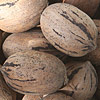Carya illinoinensis (Pecan) is a fruit tree that was imported to Israel in the 1950s from the United States for planting in commercial plantations for growing pecan nuts. It originates from the lower Mississippi Valley, in central North America and Mexico. Its scientific name was coined after the state of Illinois in the Midwest. After years of successful growing, the yellow pecan aphid, Monelliopsis pecanis, was apparently brought to Israel by mistake with an uncontrolled seedling. This caused severe harm to the plantations and almost decimated this successful branch of agriculture.
The pecan is a tall winter-deciduous tree that reaches a height of 40 m. According to estimates in its country of origin, it can reach an age of 300 years. The tree’s crown is erect and broad and it is therefore also planted as an ornamental tree which casts a wide shade. The leaves are pinnate, and carry 4-8 pairs of elongated leaflets which have a dentate margin. At the tip of the leaf axis there is a single terminal leaflet.
The tree has unisexual flowers. Male flowers in loose catkins, 8-15 cm long, dangle in the wind and disperse the pollen. The female flowers are concentrated in racemes of 3-6 flowers on short pedicels. The bloom is for a short period in the spring. In the commercial varieties, dispersion of the pollen does not always take place at the time when the female flowers develop, and it is therefore advantageous to plant trees of a fertilizing variety with the correct time of pollen dispersion.
The dry fruits have a pointed tip. They are 2.5-6 cm long and 1.5-3 cm wide. Upon ripening they dry and their shell, which originates in the perianth, turns brown, sometimes with a decoration of black veins. The fruit that is not picked opens in four valves, and contains a single seed. Pecan nuts have great nutritional value. Their caloric content is high, and they contain carbohydrates, fats, proteins, vitamins and minerals. There are studies that show that pecan fruits also have a medical value. During autumn the fruits ripen and they are eaten after drying and are used for baking cakes.
The Native Americans used to gather the pecan fruits and eat them. It was very advantageous that the dry fruits are preserved for a long time and do not rot. The Spanish who explored Mexico and the southern United States discovered the pecan in the 16th century and brought it to Europe, Asia and Africa as an agricultural crop. Later it was also brought to Australia. Pecan wood is also used for making furniture.
The pollen of pecan flowers, which disperses in the wind in large amounts during the blossoming season, causes severe allergic reactions among those who are sensitive to it. The extensive planting of pecan trees in public parks, especially in kibbutzim, caused great suffering to some of the inhabitants who are forced to leave the place for a few weeks during this season.
The fruits of the tall pecan trees used to be picked in plantations using an instrument that would shake the entire tree. Those picking the fruits do not reach the fruits at the top of the pecan trees in the parks, and the crows enjoy them. They learned to pick the fruit and to throw it from a height onto a hard surface, a street, sidewalk or paved roof, until its shell breaks and they can eat its nutritious content. Sometimes they do not succeed in breaking the fruit, and if it remains intact and reaches a place where the soil is irrigated, it can germinate into a tree that is difficult to uproot, if not performed while it is a very young seedling.
Written by Amram Eshel







